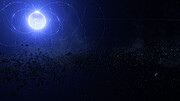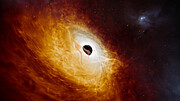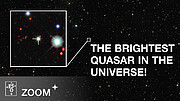Credit: X-ray: NASA/CXC/SAO; Optical: NASA/STScI; Infrared: NASA-JPL-Caltech
Observing pulsars helps us understand the evolution of massive stars, provides a way to study the physics of ultra-dense materials, and gives us a means to search for the background gravitational hum of supermassive black holes in colliding galaxies. Today, we’ll take a look at three recent research articles that explore fundamental questions in pulsar science.
How Do We Find Pulsars?
Ziteng Wang (Curtin University) and collaborators used the Australian Square Kilometre Array Pathfinder (ASKAP), a 36-dish radio interferometer, to search for circularly polarized signals from pulsars. In addition to known stars and pulsars, the observations pinpointed a strongly circularly polarized source with no known counterpart at other wavelengths. The team followed up on this promising discovery with the 64-meter Murriyang radio telescope at Parkes Observatory and found a pulsar with a rotation period of 78.72 milliseconds. The pulsar, cataloged as PSR J1032−5804, has an estimated age of 34,600 years, making it relatively young and possibly still associated with a visible supernova remnant. The team found a compact region of emission surrounding the pulsar, but they couldn’t rule out the possibility that the material belongs to unrelated nebulae.
PSR J1032−5804 is notable because its pulses are highly scattered by interstellar gas and dust. Highly scattered pulsar signals are hard to detect because scattering broadens and weakens the signal, especially at lower frequencies where pulsars should be at their brightest. Wang’s team has shown that searching at relatively high frequencies — the team’s observations were made at 3 gigahertz — is a viable way to detect scattered pulsars.
How Do Pulsars Make Their Pulses?
Ashley Bransgrove (Columbia University and Princeton University) and collaborators carried out high-resolution global simulations of a pulsar’s magnetosphere: the region immediately surrounding a pulsar where its strong magnetic field dominates the motion of charged particles. The simulations show how the rapid rotation of the pulsar lofts charged particles from its surface and accelerates them, filling the magnetosphere with gamma rays and a dense sea of electrons and their positively charged counterparts, positrons. Near the pulsar’s poles and farther out in its magnetosphere, gaps form where the electric current is mismatched, and pairs of electrons and positrons are generated in these gaps. When the gaps discharge — think of a spark, or lightning — they excite waves in the plasma and, subsequently, electromagnetic waves. The emitted radiation is similar in frequency and luminosity to observed pulsars, suggesting that electric discharge may generate the radio waves that pulsars are known for.
The team notes that it’s too soon to apply their simulations to observations of individual pulsars, and more work is needed to understand the role of gamma-ray emission, explore the details of electron–positron pair production, and extend the work to pulsars whose spin axes and magnetic axes are misaligned.
Credit: Pope et al. 2024
How Do Pulsars Interact with Their Surroundings?
The teams combined archival data from radio telescopes and the Chandra X-ray Observatory with newly collected data from NuSTAR, VERITAS, and the Fermi Gamma-ray Space Telescope to probe the nebula’s multiwavelength behavior. These observations revealed that the nebula appears far larger at radio wavelengths than at X-ray wavelengths, a common feature of pulsar wind nebulae due to the difference sources of emission: the nebula’s size at radio wavelengths is set by outflowing particles, while its size at X-ray wavelengths comes from the rate at which electrons lose energy as they spiral around magnetic field lines and emit X-rays. The nebula’s size even varies across X-ray wavelengths, appearing smaller at shorter wavelengths.
Judging from how the nebula’s size changes with wavelength, its overall energy output, and its X-ray emission over the past two decades, the authors provide a new estimate on its distance and magnetic field strength, finding it to be more distant and with a far weaker magnetic field than previously thought. By modeling how the nebula’s energy output may have evolved over time, the team also found that the Boomerang is, well, boomeranging! Roughly 1,000 years ago, a backwards-moving supernova shock wave crashed into the expanding nebula, crushing the nebula and temporarily reversing its expansion. Today, the nebula is re-expanding in the wake of the shock wave, showcasing how pulsars dynamically interact with their surroundings.
By Kerry Hensley
Citation
“Radio Emission and Electric Gaps in Pulsar Magnetospheres,” Ashley Bransgrove et al 2023 ApJL 958 L9. doi:10.3847/2041-8213/ad0556
“A Multiwavelength Investigation of PSR J2229+6114 and Its Pulsar Wind Nebula in the Radio, X-ray, and Gamma-ray Bands,” I. Pope et al 2024 ApJ 960 75. doi:10.3847/1538-4357/ad0120



























